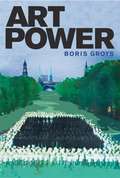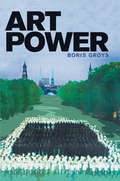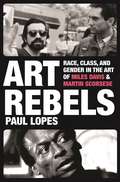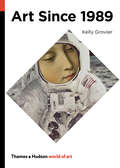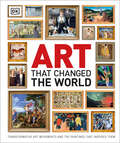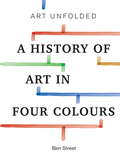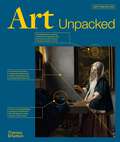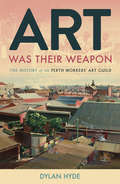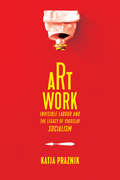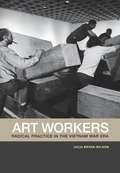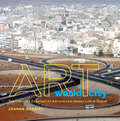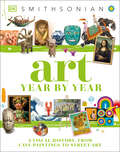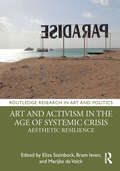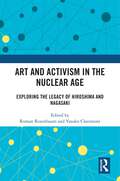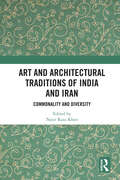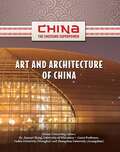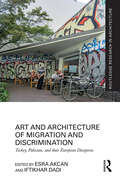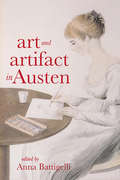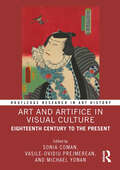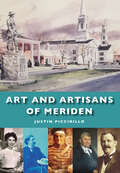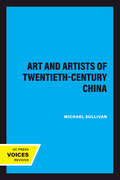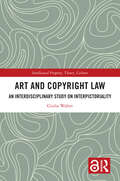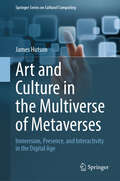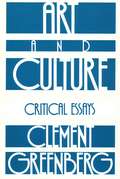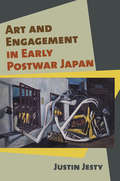- Table View
- List View
Art Power
by Boris GroysGroys examines modern and contemporary art according to its ideological function. Art, Groys writes, is produced and brought before the public in two ways; as a commodity and as a tool of political propaganda.
Art Power (The\mit Press Ser.)
by Boris GroysA new book by Boris Groys acknowledges the problem and potential of art's complex relationship to power.Art has its own power in the world, and is as much a force in the power play of global politics today as it once was in the arena of cold war politics. Art, argues the distinguished theoretician Boris Groys, is hardly a powerless commodity subject to the art market's fiats of inclusion and exclusion. In Art Power, Groys examines modern and contemporary art according to its ideological function. Art, Groys writes, is produced and brought before the public in two ways—as a commodity and as a tool of political propaganda. In the contemporary art scene, very little attention is paid to the latter function.Arguing for the inclusion of politically motivated art in contemporary art discourse, Groys considers art produced under totalitarianism, Socialism, and post-Communism. He also considers today's mainstream Western art—which he finds behaving more and more according the norms of ideological propaganda: produced and exhibited for the masses at international exhibitions, biennials, and festivals. Contemporary art, Groys argues, demonstrates its power by appropriating the iconoclastic gestures directed against itself—by positioning itself simultaneously as an image and as a critique of the image. In Art Power, Groys examines this fundamental appropriation that produces the paradoxical object of the modern artwork.
Art Rebels: Race, Class, and Gender in the Art of Miles Davis and Martin Scorsese
by Paul LopesHow creative freedom, race, class, and gender shaped the rebellion of two visionary artistsPostwar America experienced an unprecedented flourishing of avant-garde and independent art. Across the arts, artists rebelled against traditional conventions, embracing a commitment to creative autonomy and personal vision never before witnessed in the United States. Paul Lopes calls this the Heroic Age of American Art, and identifies two artists—Miles Davis and Martin Scorsese—as two of its leading icons.In this compelling book, Lopes tells the story of how a pair of talented and outspoken art rebels defied prevailing conventions to elevate American jazz and film to unimagined critical heights. During the Heroic Age of American Art—where creative independence and the unrelenting pressures of success were constantly at odds—Davis and Scorsese became influential figures with such modern classics as Kind of Blue and Raging Bull. Their careers also reflected the conflicting ideals of, and contentious debates concerning, avant-garde and independent art during this period. In examining their art and public stories, Lopes also shows how their rebellions as artists were intimately linked to their racial and ethnic identities and how both artists adopted hypermasculine ideologies that exposed the problematic intersection of gender with their racial and ethnic identities as iconic art rebels.Art Rebels is the essential account of a new breed of artists who left an indelible mark on American culture in the second half of the twentieth century. It is an unforgettable portrait of two iconic artists who exemplified the complex interplay of the quest for artistic autonomy and the expression of social identity during the Heroic Age of American Art.
Art Since 1989 (World of Art)
by Kelly GrovierAn extensive, accessible guide to the most groundbreaking and influential art from 1989 to the present The years since the collapse of the Berlin Wall in November 1989 have seen the rise of a new freedom to define art—Who makes it? Where can it be found? What is its commercial value?—and, consequently, the reevaluation of art’s place in society. Kelly Grovier surveys the dynamic developments in art practice worldwide since 1989, focusing on artists whose fresh visual vocabulary and innovation reflect these past turbulent decades. The book’s ten chapters examine the key themes in contemporary art—portraiture in the age of face transplants and facial recognition software, political activism, science, and religion, to name a few—by artists including Jeff Koons, Louise Bourgeois, Damien Hirst, George Condo, Marlene Dumas, Sean Scully, Cindy Sherman, Banksy, Ai Weiwei, Antony Gormley, Christo and Jean-Claude, Jenny Holzer, Chuck Close, and Cornelia Parker. A chapter-length timeline at the end of the book traces the evolution of art from 1989 to today by closely examining one key artwork from each year. Illustrated with the work of over 200 key artists, Art Since 1989 is a lucid and engaging look at what may prove to be one of the more tempestuous eras in human history, if not the history of art.
Art That Changed the World: Transformative Art Movements and the Paintings That Inspired Them (DK Timelines)
by DKThis is your A to Z guide to art! From cave paintings to pop art and modern masterpieces, this absorbing and beautiful art encyclopedia explores the development of art in spectacular detail. Here&’s what you&’ll find inside the pages of this visually stunning art book: • Covers every major movement in art from prehistory to the present day • Each movement is tracked in a visual timeline that showcases its key paintings and notable artists, and explains its context — the major events in its evolution • Each section ends with a stunning image of a masterwork and a curator's analysis that encapsulates its values, style, composition and subject matter • Glossary of technical terms and a comprehensive index Get ready to embark on a unique guided tour throughout the history of art. Get to know more than 700 of the greatest artists, from Michelangelo and Monet to Damien Hirst and Picasso. Discover 2,500 of the world&’s most iconic paintings, sculptures and other artwork that has shaken the art world through centuries and across continents. Truly comprehensive in scope, Art That Changed the World presents the most remarkable art movements throughout history in chronological order and explains the social and cultural background of each period. Turning-point paintings that triggered or epitomised each artistic movement are identified and explained, against a backdrop of influences — from admired techniques of an earlier artist to the changes in society that enabled new directions in art. A must-have for your bookshelf, this is an indispensable art reference book for art-lovers everywhere!
Art Unfolded: A History of Art in Four Colours
by Ben StreetDivine blueSensual redDeathly greenGlistening goldThese four colours tell the story of art in a way that few other elements can. From the pigments used to make them - sometimes wildly expensive, like ultramarine, or dangerously toxic, like emerald green - to the varied and changing meanings applied to them, these colours grant us access to fascinating stories, both of individual works of art and the world in which they were created.
Art Unpacked: 50 Works Of Art: Uncovered, Explored, Explained
by Matthew WilsonA down-to-earth, visual guidebook that shows how to “read,” understand, and get the most out of art. For beginners, art history might seem a daunting subject with complex rules and impenetrable technical language. Even for more seasoned art lovers the question of how to think about art is a perennial riddle. Art Uncovered is the perfect resource for both audiences: an engaging, visual primer for the general reader and educators. Designed like an instruction manual, fifty key artworks from around the world are deconstructed with explanations, diagrams, and close-ups in order to reveal the elements that comprise a masterpiece. Dating from the earliest times to the present, the artworks under analysis are drawn from many cultures and cover all forms of visual media, including drawing, illustration, photography, prints, and sculpture. Matthew Wilson’s simple approach, using established art historical methods, enables the reader to discover the fundamentals of art history, from considerations of function, historical context, iconography, and artists’ experience to broader issues of identity, including feminism, gender, and postcolonialism. Whether it’s the mask of Tutankhamun or Dorothea Lange’s photograph Migrant Mother, Katsushika Hokusai’s Great Wave or Kara Walker’s Gone, each image is dissected on the page in a no-nonsense style, with explanatory notes detailing artists’ sources of inspiration, associated styles and movements, plus any relevant quotes, related visuals, and other contextual and issue-led information with keywords for handy cross-referencing. The resulting book is a dynamic visual resource that will inspire and spark enjoyment of art in all its forms.
Art Was Their Weapon: The History of the Perth Workers' Art Guild
by Dylan HydeThe politics, art and culture of Perth's Workers Art Guildare detailed in this comprehensive history, as well as the personal andprofessional lives of some of the movement's key figures.The Workers' Art Guild was a left-leaning political force andinfluential cultural movement of the 1930s and 1940s in Perth. Policeand intelligence arms kept close tabs on the Guild and its members,jailing some and intimidating many others prior to and during theperiod of the banning of the Communist Party in Australia.The book covers the personal and professional lives of key figuressuch as writer Katharine Susannah Prichard and theatre maverickKeith George, while charting the influence of the Communist Party onWestern Australian artists.
Art Work: Invisible Labour and the Legacy of Yugoslav Socialism
by Katja PraznikIn Art Work, Katja Praznik counters the Western understanding of art – as a passion for self-expression and an activity done out of love, without any concern for its financial aspects – and instead builds a case for understanding art as a form of invisible labour. Focusing on the experiences of art workers and the history of labour regulation in the arts in socialist Yugoslavia, Praznik helps elucidate the contradiction at the heart of artistic production and the origins of the mystification of art as labour. This profoundly interdisciplinary book highlights the Yugoslav socialist model of culture as the blueprint for uncovering the interconnected aesthetic and economic mechanisms at work in the exploitation of artistic labour. It also shows the historical trajectory of how policies toward art and artistic labour changed by the end of the 1980s. Calling for a fundamental rethinking of the assumptions behind Western art and exploitative labour practices across the world, Art Work will be of interest to scholars in East European studies, art theory, and cultural policy, as well as to practicing artists.
Art Workers: Radical Practice in the Vietnam War Era
by Julia Bryan-WilsonThis book examines the specific social contexts of the redefinition of artistic labor, showing its centrality to artists' attempts to intervene, through their activism and art making, in a profoundly turbulent moment: the Vietnam War era.
Art World City: The Creative Economy of Artists and Urban Life in Dakar (African Expressive Cultures)
by Joanna Grabski“Insightful . . . should be on the bookshelf of anyone interested in contemporary art on the continent of Africa, its politics, its display, its economics.” —African ArtsArt World City focuses on contemporary art and artists in the city of Dakar, a famously thriving art metropolis in the West African nation of Senegal. Joanna Grabski illuminates how artists earn their livelihoods from the city’s resources, possibilities, and connections. She examines how and why they produce and exhibit their work and how they make an art scene and transact with art world mediators such as curators, journalists, critics, art lovers, and collectors from near and far. Grabski shows that Dakar-based artists participate in a platform that has a global reach. They extend Dakar’s creative economy and the city’s urban vibe into an “art world city.”“In her fine-grained analysis, Joanna Grabski demonstrates the ways that the urban environment and the sites of art production, exhibition, and sale imbricate one another to constitute Dakar as an Art World City.” —Mary Jo Arnoldi, Curator, Anthropology, National Museum of Natural History, Smithsonian“A valuable addition to the anthropology of cities and of art worlds. It stretches and revises the notion of art world to include multiple scales, and illustrates how the city enables simultaneous engagement for artists with local, national, Pan-African, and global discourses and platforms.” —City & Society“A beautiful book. The photographs, most of which are by the author, are stunning.” —College Art Association Reviews
Art Year by Year: A Visual History, From Cave Paintings to Street Art
by DKTravel through time to discover the paintings, sculptures, and decorative objects that enrich our world.Are you seeking a lavishly illustrated timeline that showcases a glorious gallery of art from all around the world? Then SI Art Year By Year may be the book for you!Over 500 images of art movements such as the Renaissance, Neoclassicism, Impressionism, and Pop Art are explored and explained, accompanied by striking visual detail that truly brings the artwork to life. Further featuring biographies of the key figures behind some of the world&’s best-known artworks, from Botticelli and Hiroshige to Goncharova and Morisot, SI Art Year By Year has something for everyone to admire. With passion in every page, you can explore: - Feature panels discussing artists, art movements, and techniques- Specific works of art analysed, with details pulled out and explained- Pages that explore a single theme through time and across different cultures- Inspiring quotes from artists add insightWith every story plotted on a timeline, the pages give a snapshot of each era, and reveal the influences and connections behind the artworks and artistic movements that have reflected our world. With more than 500 images of paintings, drawings, photographs, and sculptures, SI Art Year by Year is the ultimate visual guide to the history of art, century by century, year by year!A must-have art book for children and adults alike who are curious about art, whether you&’re an educator, an art enthusiast, or a lover of creativity seeking to explore some of the greatest known artworks throughout history, SI Art Year By Year is sure to delight.
Art and Activism in the Age of Systemic Crisis: Aesthetic Resilience (Routledge Research in Art and Politics)
by Marijke De Valck Eliza Steinbock Bram IevenThis book examines how renewed forms of artistic activism were developed in the wake of the neoliberal repression since the 1980s. The volume shows the diverse ways in which artists have sought to confront systemic crises around the globe, searching for new and enduring forms of building communities and reimagining the political horizon. The authors engage in a dialogue with these artistic efforts and their histories – in particular the earlier artistic activism that was developed during the civil rights era in the 1960s and 70s – providing valuable historical insight and new conceptual reflection on the future of aesthetic resilience. This book will be of interest to scholars in contemporary art, history of art, film and literary studies, protest movements, and social movements.
Art and Activism in the Nuclear Age: Exploring the Legacy of Hiroshima and Nagasaki
by Yasuko Claremont Roman RosenbaumThis book explores the contemporary legacy of Hiroshima and Nagasaki following the passage of three quarters of a century, and the role of art and activism in maintaining a critical perspective on the dangers of the nuclear age. It closely interrogates the political and cultural shifts that have accompanied the transition to a nuclearised world. Beginning with the contemporary socio-political and cultural interpretations of the impact and legacy of the destruction of Hiroshima and Nagasaki, the chapters examine the challenges posed by committed opponents in the cultural and activist fields to the ongoing development of nuclear weapons and the expanding industrial uses of nuclear power. It explores how the aphorism that "all art is political" is borne out in the close relation between art and activism. This multi-disciplinary approach to the socio-political and cultural exploration of nuclear energy in relation to Hiroshima/Nagasaki via the arts will be of interest to students and scholars of peace and conflict studies, social political and cultural studies, fine arts, and art and aesthetic studies.
Art and Architectural Traditions of India and Iran: Commonality and Diversity
by Nasir Raza KhanThis book presents a comprehensive overview of the historical and cultural linkages between India and Iran in terms of art and architectural traditions and their commonality and diversity. It addresses themes such as early connections between Iran, India and Central Asia; study of the Qutb Complex in Delhi; the great immigration of Turks from Asia to Anatolia; the collaboration of Indian and Persian painters; design, ornamentation techniques and regional dynamics; women and public spaces in Shahjahanabad and Isfahan; the noble-architects of emperor Shah Jahan's reign; development of Kashmir’s Islamic religious architecture in the medieval period; role of Nur Jahan and her Persian roots in the evolution of the Mughal Garden; synthesis of Indo-Iranian architecture; and confluence of Indo-Persian food culture to showcase the richness of art, architecture, and sociocultural and political exchanges between the two countries. Bringing together a wide array of perspectives, it delves into the roots of connection between India and Iran over centuries to understand its influence and impact on the artistic and cultural genealogy and the shared past of two of the oldest civilizations and regional powers of the world. With its archival sources, this book will be useful to scholars and researchers of medieval history, Indian history, international relations, Central Asian history, Islamic studies, Iranian history, art and architecture, heritage studies, cultural studies, regional studies, and South Asian studies as well as those interested in the study of sociocultural and religious exchanges.
Art and Architecture of China (China: The Emerging Superpower)
by Shelia Hollihan-ElliotChina has a rich artistic tradition extending back thousands of years. Art and Architecture of China surveys the art treasures of this vibrant civilization, from ancient and imperial China to today's People's Republic. The arts of each era are interpreted in the context of the life, culture, and politics of that era, offering insights to their meaning and showing how China's artistic output has reflected the development of Chinese society and thought. Art forms studied include ancient bronze ritual vessels and jade; the Three Perfections (calligraphy, poetry, and brush painting); ceramics and porcelain; sculpture; decorative and folk art; and modern, Western-influenced painting. Traditional Chinese architecture and town planning is also explored, revealing key technologies and design principles. In addition, today's interplay between traditional architecture and cutting-edge modernism is examined.
Art and Architecture of Migration and Discrimination: Turkey, Pakistan, and their European Diasporas (Routledge Research in Architecture)
by Iftikhar Dadi Esra AkcanThis book brings together essays by established and emerging scholars that discuss Pakistan, Turkey, and their diasporas in Europe. Together, the contributions show the scope of diverse artistic media, including architecture, painting, postcards, film, music, and literature, that has responded to the partitions of the twentieth century and the Muslim diasporas in Europe. Turkey and Pakistan have been subject to two of the largest compulsory population transfers of the twentieth century. They have also been the sites for large magnitudes of emigration during the second half of the twentieth century, creating influential diasporas in European cities such as London and Berlin. Discrimination has been both the cause and result of migration: while internal problems compelled citizens to emigrate from their countries, blatant discriminatory and ideological constructs shaped their experiences in their countries of arrival. Read together, the Partition emerges from the essays in Part I not as a pathology specific to the Balkans, Middle East, or South Asia, but as a central problematic of the new political realities of decolonization and nation formation. The essays in Part II demonstrate the layered histories and multiple migration paths that have shaped the experiences of Berliners and Londoners. This analysis furthers the study of modernism and migration across the borders of, not only the nation-state, but also class, race, and gender. As a result, this book will be of interest to a broad multidisciplinary academic audience including students and faculty, artists, architects and planners, as well as non-specialist general public interested in visual arts, architecture and urban literature.
Art and Artifact in Austen (Victorian Literature and Culture Series)
by Anna BattigelliJane Austen distinguished herself with genius in literature, but she was immersed in all of the arts. Austen loved dancing, played the piano proficiently, meticulously transcribed piano scores, attended concerts and art exhibits, read broadly, wrote poems, sat for portraits by her sister Cassandra, and performed in theatricals. For her, art functioned as a social bond, solidifying her engagement with community and offering order. And yet Austen’s hold on readers’ imaginations owes a debt to the omnipresent threat of disorder that often stems—ironically—from her characters’ socially disruptive artistic sensibilities and skill. Drawing from a wealth of recent historicist and materialist Austen scholarship, this timely work explores Austen’s ironic use of art and artifact to probe selfhood, alienation, isolation, and community in ways that defy simple labels and acknowledge the complexity of Austen’s thought.
Art and Artifice in Visual Culture: Eighteenth Century to the Present (Routledge Research in Art History)
by Michael Yonan Sonia Coman Vasile-Ovidiu PrejmereanThis edited volume explores the notion of “artifice” in modern visual culture, ranging from the eighteenth century to the present, in countries around the globe.Artifice has been regarded as a primarily Western phenomenon, playing as it does a central role in European art theory since the Renaissance. This volume proposes that artifice is better understood as a transcultural artistic phenomenon and requires far broader conceptualization across international contexts. It acquaints readers with works of art, visual modes of communication, and concepts originating in France, Germany, the United States, Japan, and China, and includes painting, sculpture, drawings, prints, photographs, film, and virtual reality/augmented reality (VR/AR) objects. Contributors demonstrate how practices of artifice function as both symbol and form, in parallel and divergent ways, in multiple cultural settings.The book will be of interest to scholars working in art history, visual culture, and material culture.
Art and Artisans of Meriden
by Justin PiccirilloLocated between the urban centers of New York City and Boston, the city of Meriden, Connecticut, has been an important hub for art and artisans for over a century. The city's rich tradition of innovative design has long been acknowledged as an outstanding contribution to the larger development of American art. Many of America's leading artists have come from or lived in Meriden, including 19th-century sculptor Chauncey B. Ives, early-20th-century painter Ethel Easton Paxson, and, in more recent years, children's book author/ illustrator Tomie dePaola. Meriden's art scene blossomed with an abundance of artistic talent at the beginning of the 20th century. This convergence of artists and designers ultimately led to the creation of an artist colony. In late 1907, the Arts and Crafts Association of Meriden was formed and, to its acclaim, remains the second-oldest continuously active arts organization in the state. Today, Meriden's tradition as a center for art, design, and aesthetics continues.
Art and Artists of Twentieth-Century China
by Michael SullivanThis visually stunning book focuses on the rebirth of Chinese art in the twentieth century under the influence of Western art and culture. Michael Sullivan, recognized throughout the world as a leading scholar of Chinese art, vividly documents the conflicting pulls of traditional and Western values on Chinese art and provides 364 illustrations, in color and black-and-white, to show the great range of artistic expression and the historical processes that occurred within various movements. A substantial biographical index of twentieth-century Chinese artists is a valuable addition to the text.Sullivan discusses artists and their work against China's background of oppression and relaxation, despair and hope. He expertly conveys the diverse and at times bizarre intertwining of Chinese cultural history and art during this century. Included are the intense debates between traditionalists and reformers, the creation of the first art schools, and the birth of the idea—shocking in ethnocentric China—that art is a world language that obliterates all frontiers. The scholarly traditions of classical Chinese painting, the belated discovery of Western modernism, the artistic upheaval under Communism, and China's rethinking of the very nature of art all have a place in Sullivan's fascinating history.Michael Sullivan has known many of the major figures in China's modern art movement of the 1930s and 1940s and has also gained the confidence of younger artists who rose to prominence following the 1979 "Peking Spring." This long-awaited book—richly documented and abundantly illustrated—is a capstone to Sullivan's work and will be enthusiastically welcomed by art lovers everywhere.
Art and Copyright Law: An Interdisciplinary Study on Interpictoriality (Intellectual Property, Theory, Culture)
by Giulia WalterThis book tackles the lack of synchronicity between art and copyright law, proposing practical and interdisciplinary tools through which to navigate this conflict.In the last decades, high profile lawsuits have been filed against artists accused of plagiarism including Jeff Koons, Barbara Kruger and Andy Warhol. This book demonstrates how these cases are at odds with contemporary artistic reality, in which the use of antecedent visual forms is common practice. Focusing on the dichotomies of “original/copy” and of “old/new”, this work addresses this phenomenon from both theoretical and legal perspectives. Using Swiss copyright law as the main case study, the book comparatively assesses other international legal frameworks. Through understanding the origins of the conflict between art and copyright, the book highlights solutions to handle copyright cases with a new methodological approach.The book will be of interest to researchers in the field of art and copyright law, intellectual property and art.The Open Access version of this book, available at http://www.taylorfrancis.com, has been made available under a Creative Commons Attribution-Non Commercial-No Derivatives (CC BY-NC-ND) 4.0 license.
Art and Culture in the Multiverse of Metaverses: Immersion, Presence, and Interactivity in the Digital Age (Springer Series on Cultural Computing)
by James HutsonDrawing on the art historical framing of Location, Place, and Identity, this book will examine how the factors of Immersion, Presence, and Interactivity of XR are shaping our understanding of the world and our place within it. Location refers to the specific geographical or spatial context in which a work of art is created or experienced. Place refers to the social, cultural, and historical context of that location. Identity refers to the ways in which individuals and communities construct and express their sense of self and belonging within those contexts. Through case studies and theoretical analysis, Art and Culture in the Multiverse of Metaverses - Immersion, Presence, and Interactivity in the Digital Age, will explore how the factors of Immersion, Presence, and Interactivity of XR can be aligned with these art historical concepts, providing new opportunities for understanding and engaging with Location, Place, and Identity. For example, XR can be used to create immersive experiences of historical locations and cultural sites, allowing users to explore and engage with them in ways that would otherwise be impossible. Additionally, XR can be used to create interactive artworks that engage with issues of identity and belonging, creating new possibilities for self-expression and exploration.
Art and Culture: Critical Essays
by Clement Greenberg"Clement Greenberg is, internationally, the best-known American art critic popularly considered to be the man who put American vanguard painting and sculpture on the world map. . . . An important book for everyone interested in modern painting and sculpture."--The New York Times
Art and Engagement in Early Postwar Japan
by Justin JestyJustin Jesty’s Art and Engagement in Early Postwar Japan reframes the history of art and its politics in Japan post-1945. This fascinating cultural history addresses our broad understanding of the immediate postwar era moving toward the Cold War and subsequent consolidations of political and cultural life. At the same time, Jesty delves into an examination of the relationship between art and politics that approaches art as a mode of intervention, but he moves beyond the idea that the artwork or artist unilaterally authors political significance to trace how creations and expressive acts may (or may not) actually engage the terms of shared meaning and value.Art and Engagement in Early Postwar Japan centers on a group of social realists on the radical left who hoped to wed their art with anti-capitalist and anti-war activism, a liberal art education movement whose focus on the child inspired innovation in documentary film, and a regional avant-garde group split between ambition and local loyalty. In each case, Jesty examines writings and artworks, together with the social movements they were a part of, to demonstrate how art—or more broadly, creative expression—became a medium for collectivity and social engagement. He reveals a shared if varied aspiration to create a culture founded in amateur-professional interaction, expanded access to the tools of public authorship, and dispersed and participatory cultural forms that intersected easily with progressive movements. Highlighting the transformational nature of the early postwar, Jesty deftly contrasts it with the relative stasis, consolidation, and homogenization of the 1960s.
